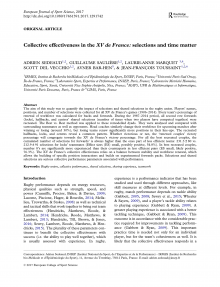European Journal of Sport Science
ADRIEN SEDEAUD, GUILLAUME SAULIÈRE, LAURIE-ANNE MARQUET, SCOTT DEL VECCHIO, AVNER BAR-HEN & JEAN-FRANÇOIS TOUSSAINT
The aim of this study was to quantify the impact of selections and shared selections in the rugby union. Players’ names, positions, and number of selections were collected for all XV de France’s games (1906–2014).
Every team’s percentage of renewal of workforce was calculated for backs and forwards. During the 1987–2014 period, all second row forwards (locks), halfbacks, and centres’ shared selections (number of times when two players have competed together) were recreated. The Best vs. Rest method was applied to these remodelled dyads. They were analysed and compared with surrounding teammates as well as opponents. Head coaches similarly change their workforce for upcoming matches after winning or losing (around 30%), but losing teams renew significantly more positions in their line-ups. The recreated halfbacks, locks, and centres reveal a common pattern. Whether victorious or not, the ‘renewed couples’ victory percentage will congregate towards the XV de France’s victory percentage. For all the best recreated couples, the cumulated number of selections for forwards’ is always higher than the ones part of less efficient teams: 231.3 ± 80 vs. 212.9 ± 91 selections for locks’ teammates (Effect sizes (ES) small, possibly positive, 54.8%). In best recreated couples, number 8’s are significantly more experienced than their counterparts in less efficient pairs (ES small, likely positive, 76.3%).
The XV de France’s collective effectiveness relies on a balance between stability and workforce renewal, which allows the building of specific position interactions and builds on experimented forwards packs. Selections and shared selections are serious collective performance parameters associated with performance.
